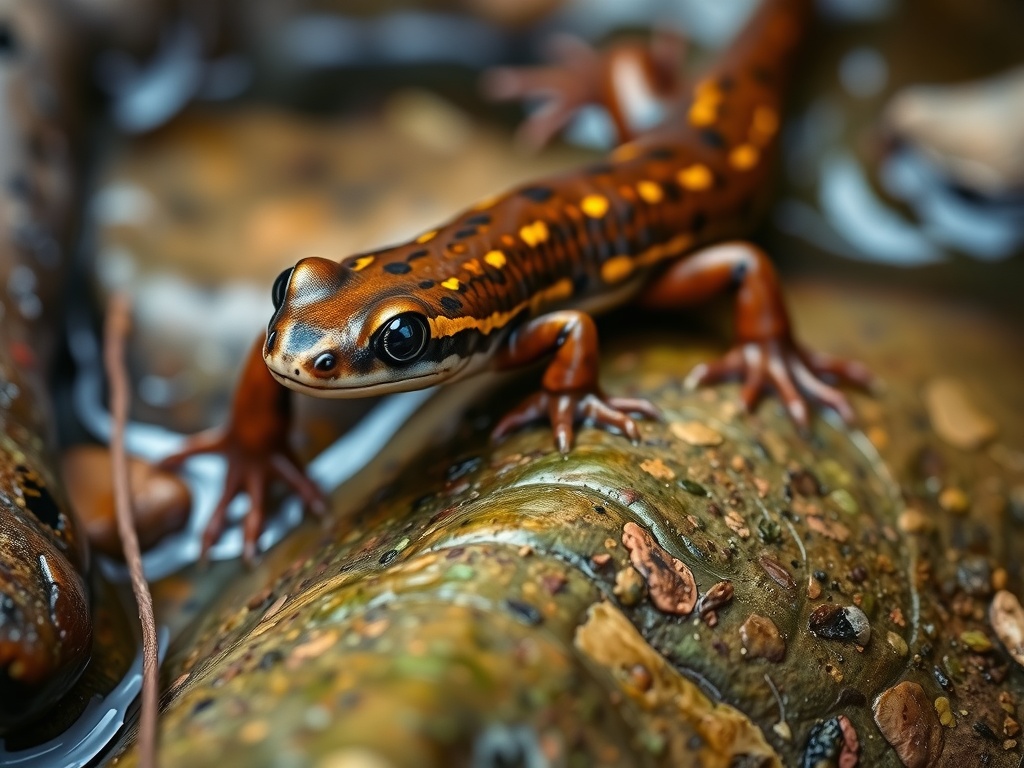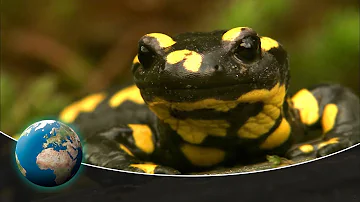
Sardinian Brook Salamander
Euproctus platycephalus

Meet the Sardinian Brook Salamander
The Sardinian Brook Salamander is a medium-sized amphibian endemic to the island of Sardinia, Italy. It has a flattened head and body, with smooth, moist skin that is typically brown or olive, often mottled with lighter or darker patches. This salamander is highly aquatic, spending the majority of its life in clean, cool, fast-flowing mountain streams and brooks. Due to its restricted range and habitat specificity, it is particularly vulnerable to water pollution and habitat disturbance.
Classification
Amphibian
Habitat
Mountain streams and brooks
Diet
Carnivore
Lifespan
8-12 years
Conservation
Endangered
Weight
6-12 grams
📖Fascinating Facts
Aquatic Specialist
The Sardinian Brook Salamander is highly adapted to life in cool, fast-flowing streams, rarely venturing far from water.
Limited Range
This species is found only on the island of Sardinia, making it extremely vulnerable to local environmental changes.
Direct Development
Unlike many amphibians, its eggs hatch into miniature versions of the adults, skipping a free-swimming larval stage.
📋Detailed Description
The Sardinian Brook Salamander (Euproctus platycephalus) is a medium-sized urodeline amphibian, typically reaching a total length of 12–15 cm, with males generally smaller than females. Its most distinctive anatomical features are a dorsoventrally flattened head and body, which facilitate movement under stones and in the shallow, fast-flowing waters of its montane habitat. The skin is smooth and moist, colored in shades of olive, brown, or gray, often with irregular lighter or darker mottling that provides camouflage among stream substrates. The limbs are relatively short but robust, and the tail is laterally compressed, aiding in swimming. Unlike many other newts, E. platycephalus lacks a prominent dorsal crest in both sexes. The eyes are positioned dorsally and are relatively small, an adaptation to its largely aquatic and crepuscular lifestyle. The species possesses well-developed lungs but relies heavily on cutaneous respiration, especially in oxygen-rich, cold water. Sexual dimorphism is subtle, but during the breeding season, males may exhibit slightly swollen cloacal regions. The species is highly aquatic, rarely venturing onto land except during dispersal or in response to habitat desiccation.
💡 Did you know?
This salamander does not go through a fully aquatic larval stage like many other amphibians; its young resemble miniature adults soon after hatching.
🔬Research & Sources
Wikipedia Summary
The Sardinian brook salamander or Sardinian mountain newt is a species of salamander in the family Salamandridae found only in Sardinia, Italy.
Last Modified: 1/7/2025
🎭Behavior & Social Structure
Euproctus platycephalus is primarily nocturnal and crepuscular, spending daylight hours concealed under stones, submerged logs, or within crevices to avoid predators and desiccation. It is a solitary species outside the breeding season, exhibiting territoriality, especially among males. Feeding occurs mostly at dusk and during the night, with individuals preying on a variety of aquatic invertebrates such as insect larvae (notably Trichoptera, Ephemeroptera, and Diptera), small crustaceans, annelids, and occasionally tadpoles or fish eggs. The salamander employs a sit-and-wait or slow stalking strategy, using its sensitive lateral line system to detect prey movements in the water. Social interactions are limited, but during the breeding season, males may engage in ritualized displays and gentle physical contests over access to optimal oviposition sites. The species is known for its site fidelity, often returning to the same microhabitat year after year.
👶Reproduction & Life Cycle
Breeding in E. platycephalus typically occurs from late winter through early summer (February to June), coinciding with increased water flow and optimal temperatures (10–16°C). Courtship involves a series of tactile and chemical cues, with the male performing a tail-fanning display to direct pheromones toward the female. Fertilization is internal; the male deposits a spermatophore on the substrate, which the female picks up with her cloaca. Females lay 30–100 eggs singly or in small clusters, attaching them to the undersides of stones or aquatic vegetation in well-oxygenated, flowing water. Embryonic development lasts 4–6 weeks, depending on water temperature. Larvae are fully aquatic, exhibiting external gills and a cryptic coloration. Metamorphosis occurs after 8–12 months, but in some high-altitude or perennial stream populations, larvae may overwinter or even exhibit paedomorphosis (retention of larval features into sexual maturity). Parental care is absent after oviposition.
🛡️Adaptations & Survival
The Sardinian Brook Salamander exhibits several adaptations to its cold, fast-flowing stream environment. Its flattened body and head reduce resistance to water currents and allow it to hide under rocks. The laterally compressed tail enhances swimming efficiency. The skin is highly permeable, facilitating cutaneous respiration in oxygen-rich waters, and the species is highly sensitive to changes in water quality. Its cryptic coloration provides camouflage against predators such as fish and birds. The lateral line system, more commonly associated with fish, is well-developed and allows detection of minute water vibrations. Behavioral adaptations include nocturnality to avoid diurnal predators and desiccation, and strong site fidelity to stable microhabitats. The ability to undergo paedomorphosis in some populations is an evolutionary response to the unpredictability of stream permanence.
📚Research Sources
🎨Cultural Significance
Due to its secretive habits and limited distribution, the Sardinian Brook Salamander holds little direct significance in Sardinian folklore or traditional practices. However, it is increasingly recognized as a flagship species for freshwater ecosystem conservation on the island. Local environmental groups and educational programs use E. platycephalus to highlight the importance of preserving Sardinia's unique biodiversity and clean water resources. Its presence is sometimes regarded as an indicator of healthy, unpolluted streams.
🔬Recent Research & Discoveries
Recent research has focused on the genetic diversity and population structure of E. platycephalus, revealing significant genetic differentiation among isolated stream systems, which has implications for conservation management. Studies on larval development and paedomorphosis have provided insights into the species' adaptability to variable hydrological conditions. Ongoing monitoring by Italian and international herpetologists tracks population trends and assesses the effectiveness of conservation interventions. There is also growing interest in the species' role as a bioindicator for freshwater ecosystem health, given its sensitivity to pollution and habitat alteration.
🎥Wildlife Videos

The Wonderful Wildlife of Sardinia | Free Documentary Nature
The Wonderful Wildlife of Sardinia | Free Nature Documentary Sardinia has always been the epitome of pure wilderness, ...
Free Documentary - Nature

Night of the Salamander - The Secrets of Nature
The film reveals all the miracles and curiosities in the salamander world that, until now, were only known to a few experts in the ...
Go Wild

Nocturnal wanderer: The fire salamander
Almost everyone knows of him, but very rarely does anyone actually get to see this nocturnal wanderer. This is because he leads ...
Free High-Quality Documentaries

Into the Forest: Amphibian Nature Documentary
The Fire Salamander and its plight with Bsal are featured. Bsal is a microscopic fungus that was accidentally imported into Europe ...
Bryan Maltais

Metamorphosis: Amphibian Nature Documentary
Instagram: https://www.instagram.com/intotheforestdocu/?hl=en Facebook: ...
Bryan Maltais

THE AMAZING SARDINIAN BROOK SALAMANDER
As aventuras do Tiago.
Marcio Oliveira
🌍Habitat Information
The Sardinian Brook Salamander typically inhabits Mountain streams and brooks environments. Sardinian Brook Salamanders have adapted to their environments with specialized features and behaviors.
Primary Habitat:
Mountain streams and brooks
More detailed habitat information will be available soon.
🛡️Conservation Status
The Sardinian Brook Salamander is currently classified as Endangered. Conservation efforts are crucial for preserving this species for future generations.
Common Threats:
- 🏠Habitat loss and fragmentation
- 🌡️Climate change impacts
- 🎯Hunting and poaching
- 🏭Human-wildlife conflict
⚠️Threats & Conservation Challenges
Euproctus platycephalus is classified as Endangered due to its extremely restricted range (endemic to Sardinia), fragmented populations, and ongoing habitat loss. Major threats include water pollution from agricultural runoff, livestock grazing, and domestic waste, which degrade water quality and reduce oxygen levels. Stream modification, damming, and water abstraction for irrigation or human consumption alter hydrological regimes, leading to habitat desiccation or loss of breeding sites. Introduced predatory fish and crayfish pose significant predation risks to both larvae and adults. Climate change is expected to exacerbate drought frequency and intensity, further threatening stream habitats. Population trends show ongoing declines, with some subpopulations extirpated in recent decades. Conservation challenges include the need for habitat restoration, improved water management, and public awareness campaigns.
🔬Scientific Classification
Scientific Name
Euproctus platycephalus
Classification Hierarchy
🔍 About Taxonomic Classification
Taxonomic classification is a hierarchical system used by scientists to classify and organize living organisms based on shared characteristics and evolutionary relationships.
The system moves from broad categories (Kingdom) to increasingly specific ones, with each animal's scientific name typically consisting of its Genus and species.
📝Community Notes
Share your observations and insights about the Sardinian Brook Salamander with our community of wildlife enthusiasts.
Join Our Community
Sign in to share your observations and connect with fellow wildlife enthusiasts.
Sign In to ContributeNo community notes yet
Be the first to share your observations about the Sardinian Brook Salamander!
Explore Sardinian Brook Salamander
Select a tab above to learn more about this amazing animal.
📸Photo Gallery
No photos available for this animal yet.
🌟Discover More Wildlife
Continue your journey of discovery with more fascinating animals from our database
